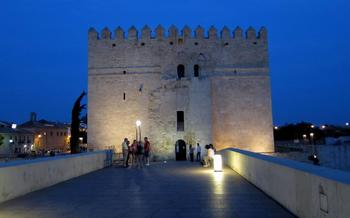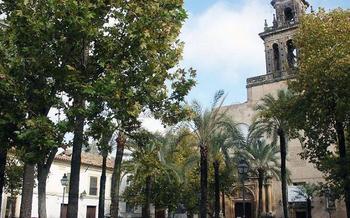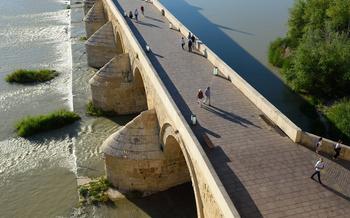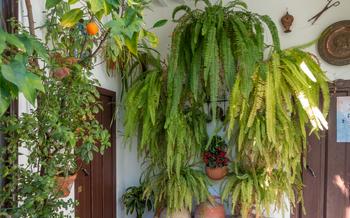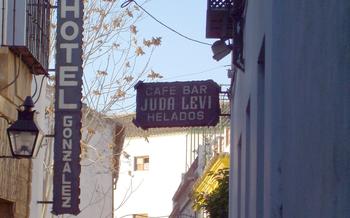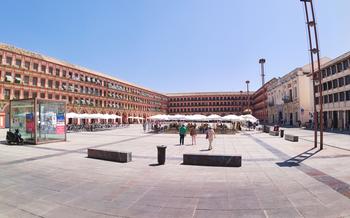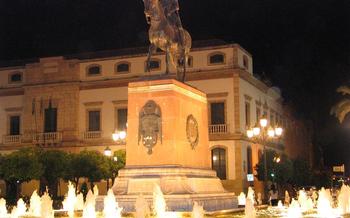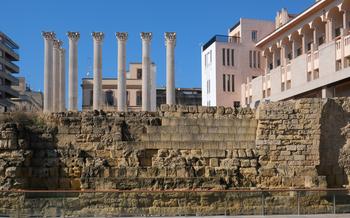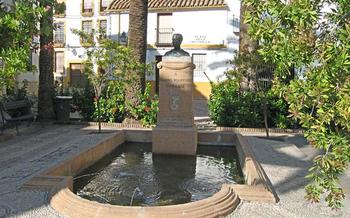
Puente de Miraflores
- Puente de Miraflores: A Majestic Roman Bridge in Córdoba
- Location and Accessibility
- History and Construction
- Architectural Highlights
- Exploring the Area Around the Bridge
- Best Time to Visit
- Tips for Photography Enthusiasts
- Walking Along the Bridge
- Visiting the Bridge with Children
- The Bridge in Literature and Art
- Puente de Miraflores and the Guadalquivir River
- Insider Tip: Hidden Gem Nearby
Puente de Miraflores: A Majestic Roman Bridge in Córdoba
The Puente de Miraflores, a remarkable Roman bridge located in the heart of Córdoba, Spain, stands as a testament to the city's rich history and architectural prowess. Built over the Guadalquivir River, this ancient structure has witnessed the passage of time, serving as a vital link between different parts of the city and playing a crucial role in trade and commerce. The bridge's enduring beauty and historical significance make it a must-see attraction for any visitor to Córdoba.
The Puente de Miraflores is an awe-inspiring sight, showcasing the ingenuity and engineering skills of the ancient Romans. Its graceful arches, intricate stonework, and imposing presence create a captivating spectacle that transports visitors back in time. Whether viewed from afar or up close, the bridge exudes an aura of grandeur that leaves a lasting impression.
As one strolls along the bridge, they are treated to stunning panoramic views of Córdoba's historic center. The glistening waters of the Guadalquivir River, the majestic Alcázar fortress, and the iconic Mezquita-Catedral, with its distinctive bell tower, form a picturesque backdrop that is sure to captivate and inspire. The bridge offers a unique perspective from which to appreciate the city's architectural heritage and the natural beauty of its surroundings.
Location and Accessibility
The Puente de Miraflores is situated in the heart of Córdoba, Spain, spanning the serene waters of the Guadalquivir River. Its exact address is Calle del Puente, 14009 Córdoba, Spain. The bridge is easily accessible on foot, allowing visitors to immerse themselves in the city's enchanting streets and plazas. For those arriving by public transport, buses 3 and 12 stop nearby, offering convenient connections to other parts of the city. Taxis are also readily available in the area. While there is limited parking in the immediate vicinity, it is advisable to consider alternative transportation options to fully experience Córdoba's pedestrian-friendly charm.
The Puente de Miraflores stands in close proximity to several other notable attractions, making it an ideal starting point for exploring the city. The magnificent Mezquita-Catedral, a UNESCO World Heritage Site and one of the most iconic landmarks of Córdoba, is just a short walk away. The Alcázar de los Reyes Cristianos, a stunning palace-fortress with lush gardens, is also within easy reach. Visitors can delve deeper into the city's Roman heritage by visiting the Templo Romano, a well-preserved Roman temple located a few steps from the bridge.
History and Construction
The Puente de Miraflores has a rich and fascinating history, dating back to the Roman era. Constructed in the 1st century AD, it was part of a strategic network of roads and bridges that facilitated trade and communication throughout the Roman Empire. The bridge served as a vital link between Córdoba and the surrounding region, allowing goods and people to cross the Guadalquivir River safely and efficiently.
Over the centuries, the bridge underwent various modifications and repairs, reflecting the changing needs and circumstances of Córdoba. In the 10th century, the Moors, who ruled much of Spain at the time, made significant alterations to the bridge, including the addition of towers and fortifications. These additions were intended to strengthen the bridge's defensive capabilities and protect the city from potential attacks.
In the 13th century, after the Christian reconquest of Córdoba, the bridge was restored and expanded. The Moors' defensive structures were removed, and the bridge was widened to accommodate increased traffic. These modifications made the bridge more accessible and convenient for both local residents and travelers.
Today, the Puente de Miraflores stands as a testament to the enduring legacy of Roman engineering and the rich history of Córdoba. It has been declared a National Monument of Spain and continues to serve as a pedestrian bridge, allowing visitors to cross the Guadalquivir River and admire the stunning views of the city.
Architectural Highlights
The Puente de Miraflores stands out for its impressive stone arch design, a testament to Roman engineering prowess. Its 16 arches, each measuring approximately 4 meters in width and 6 meters in height, create a rhythmic sequence that spans the Guadalquivir River. The arches are supported by robust piers, adorned with decorative moldings and inscriptions that hint at the bridge's rich history.
One of the most striking features of the bridge is its remarkably preserved state. Despite centuries of wear and tear, the original Roman construction remains largely intact, a testament to the quality of materials and craftsmanship employed by the ancient builders. The bridge's durability is further enhanced by its strategic location, as it was built on a solid bedrock foundation that has withstood the test of time.
Exploring the Area Around the Bridge
Beyond its historical significance, the Puente de Miraflores offers a captivating glimpse into Córdoba's vibrant culture and lifestyle. Take a leisurely stroll along the narrow, cobblestone streets that surround the bridge, and you'll be greeted by charming plazas, delightful shops, and inviting restaurants. Browse local boutiques for unique souvenirs crafted by skilled artisans, or savor the flavors of traditional Cordoban cuisine at a nearby eatery. As the evening sets in, the area transforms into a bustling hub of activity, with locals and tourists alike gathering to enjoy the lively atmosphere. Don't miss this opportunity to immerse yourself in the city's vibrant spirit, soak up the local customs, and capture the essence of Córdoba through its people and traditions.
Best Time to Visit
The best time to visit the Puente de Miraflores is during the shoulder seasons of spring (April-May) and autumn (September-October), when the weather is pleasant and the crowds are smaller. The ideal time of day to visit the bridge is in the early morning or late afternoon, when the sun is low in the sky and the light is softer, creating a magical atmosphere.
Avoid visiting during the hot summer months (June-August), as the temperatures can be oppressive and the bridge can get crowded with tourists. If you do visit during the summer, be sure to bring plenty of water, wear sunscreen, and plan your visit for early in the morning or late in the afternoon to avoid the hottest part of the day.
Tips for Photography Enthusiasts
The Puente de Miraflores presents a photographer's paradise, offering ample opportunities to capture its grandeur and historical charm. To make the most of your photographic experience, consider the following tips:
-
Camera Settings: Ensure your camera is set to a low ISO to minimize noise and maintain image quality. Experiment with different shutter speeds and apertures to achieve the desired depth of field and motion blur effects.
-
Capturing the Bridge's Grandeur: Position yourself at a distance to capture the entire bridge in its majesty. Use a wide-angle lens to emphasize its scale and surroundings.
-
Exploring Different Angles: Move around the bridge to capture it from various perspectives. Take shots from below, above, and alongside the bridge to showcase its architectural details and relationship with the river.
-
Incorporating the Surrounding Scenery: Include elements of the surrounding landscape in your compositions. The lush vegetation, historical buildings, and picturesque streets add depth and context to your photos.
Walking Along the Bridge
Safety is paramount when strolling along the Puente de Miraflores. Observe basic precautions like adhering to designated walkways, refraining from leaning over the edges, and being mindful of oncoming cyclists or joggers. Remember, the bridge is a shared space, so be respectful of other visitors and locals alike.
Take your time to savor the captivating views from various vantage points. Gaze downstream towards the majestic Alcázar and the Roman bridge, or upstream towards the city's modern skyline. Each perspective unveils a unique panorama of Córdoba's architectural wonders.
As you traverse the bridge, let the historical significance wash over you. Imagine the countless individuals who have crossed this very path throughout the centuries – Romans, Moors, Christians, and modern-day Cordobans. Each footstep carries a story, connecting you to the rich tapestry of the city's past.
Embrace the opportunity to connect with the local culture. Observe the daily life unfolding around you – fishermen casting their lines, joggers pounding the pavement, or couples strolling hand in hand. Engage in friendly conversations with locals, who will gladly share their insights and stories about the bridge and their beloved city.
Visiting the Bridge with Children
When visiting the Puente de Miraflores with children, there are several ways to make the experience both educational and enjoyable. Engage them in interactive learning activities by asking questions about the bridge's history, construction, and significance. Encourage them to sketch or photograph the bridge from different angles to enhance their observation skills. Bring along a magnifying glass to examine the intricate carvings and inscriptions, turning the bridge into a treasure hunt.
Storytelling can bring the bridge to life for kids. Share tales of ancient Roman traders crossing the bridge, knights defending the city, or local legends associated with the site. Use the bridge as a backdrop for imaginative games, such as pretending to be travelers on a journey or soldiers guarding the city.
Make the visit interactive by allowing children to touch and feel the bridge's ancient stones, explaining how they have stood the test of time. Encourage them to imagine the lives of people who crossed the bridge centuries ago. By connecting history with their own experiences, children can develop a deeper appreciation for the bridge and its role in Córdoba's past.
The Bridge in Literature and Art
The Puente de Miraflores has captured the imagination of artists and writers throughout history, becoming a recurring motif in local literature and art. In the novel "The Shadow of the Wind" by Carlos Ruiz Zafón, the bridge serves as a backdrop for a mysterious encounter between two characters, adding an air of intrigue to the story. Local poets have penned verses about the bridge's beauty and historical significance, immortalizing it in their words. Paintings and sketches depicting the bridge adorn the walls of galleries and museums in Córdoba, showcasing its enduring appeal as an artistic subject. The bridge's iconic status is further reflected in its frequent appearance on souvenirs and postcards, serving as a tangible reminder of Córdoba's rich heritage for visitors and locals alike.
Puente de Miraflores and the Guadalquivir River
The Puente de Miraflores stands as a testament to the enduring relationship between Córdoba and the Guadalquivir River. The river has played a pivotal role in shaping the city's history, economy, and culture, and the bridge has served as a vital link between the two.
From its inception, the bridge's primary purpose was to facilitate trade and transportation across the Guadalquivir. The river's navigable waters provided a direct route for goods and people to travel between Córdoba and other regions of Spain and beyond. The bridge's strategic location allowed merchants and travelers to cross the river safely and efficiently, contributing to the city's prosperity and growth.
Beyond its practical function, the Guadalquivir River has also influenced the bridge's aesthetic and symbolic significance. The river's meandering course and lush riparian vegetation create a picturesque backdrop for the bridge, enhancing its visual appeal and making it a popular spot for locals and tourists alike to stroll, relax, and admire the scenery.
The bridge's connection to the river also adds to its symbolic importance. The Guadalquivir River is a symbol of life, fertility, and abundance, and the bridge that spans it represents the city's enduring connection to these essential elements. The bridge stands as a reminder of Córdoba's dependence on the river and the vital role it has played in shaping the city's identity and destiny.
Insider Tip: Hidden Gem Nearby
Beyond the imposing Puente de Miraflores, a hidden gem awaits discovery just a short stroll away. Nestled along the banks of the Guadalquivir River, the Ermita de San Antonio de la Cruz is a charming 14th-century hermitage that exudes a tranquil atmosphere. Step inside to admire its beautifully preserved Mudejar-style architecture, featuring intricate stuccowork and vibrant azulejo tiles. The hermitage is a serene oasis, offering a respite from the bustling city and a glimpse into Córdoba's rich religious heritage. Don't miss this hidden gem for a moment of contemplation and a deeper connection to the city's past.
